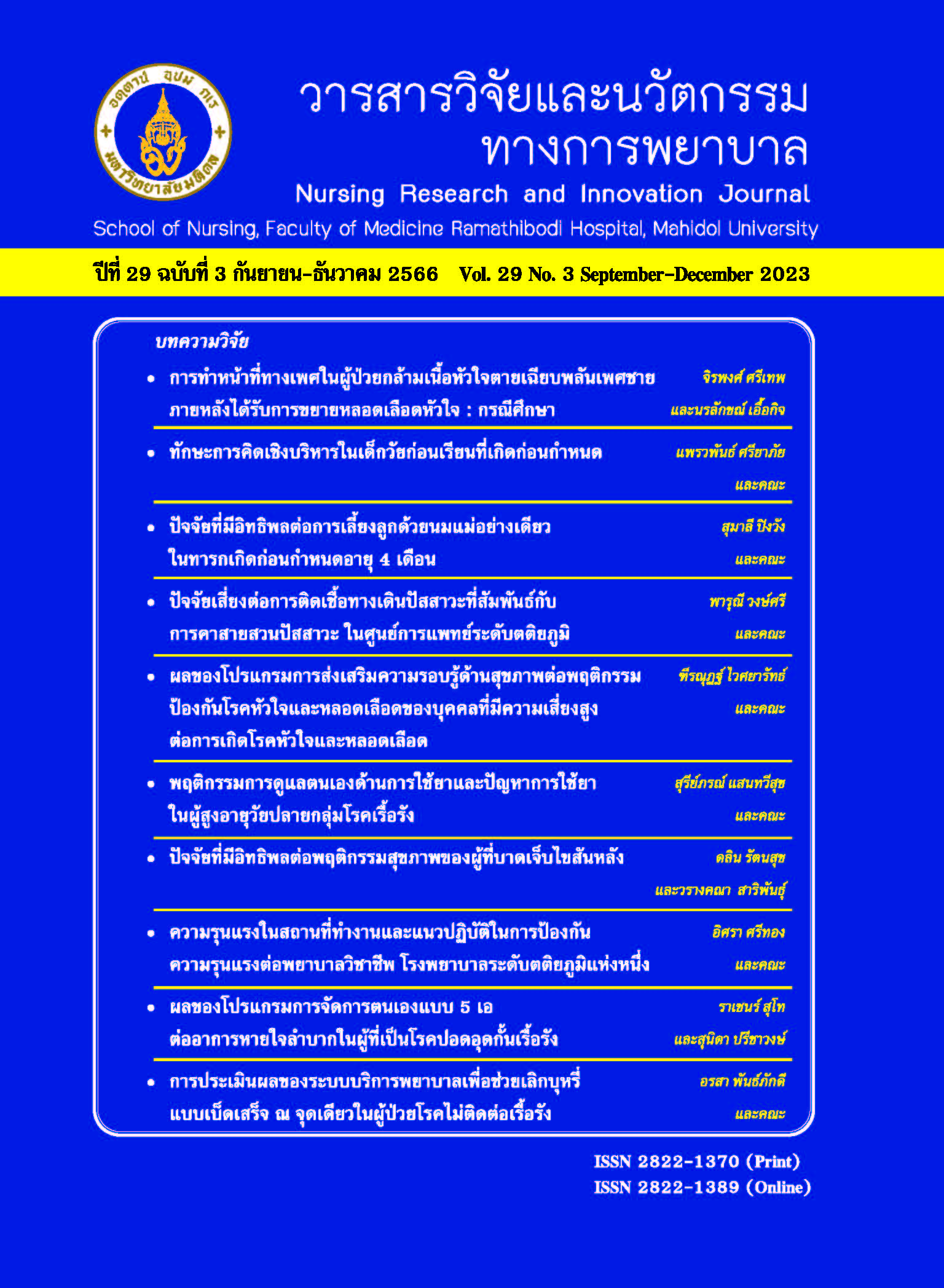Workplace Violence and Workplace Violence Prevention Guidelines for Professional Nurses at a Tertiary Hospital
Main Article Content
Abstract
This mixed-method research aimed to explore the situation of workplace violence,develop workplace violence prevention guidelines for professional nurses, and examine the feasibility of applying the guidelines in a tertiary hospital. The sample of the first phase, studying the situation and needs, consisted of 304 professional nurses who had worked for at least one year. The second phase, developing the guidelines, included 51 professional nurses who had experienced workplace violence, and 55 personnel were recruited in the third phase to examine the feasibility of applying the developed guidelines. Data were collected using the Workplace Violence among Professional Nurses Questionnaire, the Feasibility of Applying the Guideline Questionnaire, and probing questions for focus group discussion and in-depth interviews. Data were analyzed using descriptive statistics and Colaizzi’s descriptive phenomenological method.The findings about the situation of workplace violence revealed that 16.78% of professional nurses experienced workplace violence within the past one year. Workplace violence included psychological violence (6.91%), physical violence (2.63%), and sexual violence (1.31%).The causes of workplace violence consisted of personal factors: uncontrollable anger, aggressiveness, anxiety, upset, dissatisfaction due to cutting queues, unsuitable room, workload assignment,and environmental factors:inappropriate service behavior of personnel. The workplace violence affected mostly professional nurses’psychological well-being.Secondly, the developed workplace violence prevention guidelines included reducing working alone, limiting visitors to patients, installing a closed-circuit television system, and developing a training program for workplace violence management. Lastly,participants agreed that the developed guidelines could be implemented in their hospital at a high level. The hospital administrators can use the findings to develop workplace violence prevention guidelines and strengthen a safety working environment for medical personnel.
Keywords:Professional nurses, Violence prevention guidelines,Workplace violence
Article Details

This work is licensed under a Creative Commons Attribution-NonCommercial-NoDerivatives 4.0 International License.
บทความ ข้อมูล เนื้อหา รูปภาพ ฯลฯ ที่ได้รับการตีพิมพ์ในรามาธิบดีพยาบาลสาร ถือเป็นลิขสิทธิ์ของวารสาร หากบุคคลหรือหน่วยงานใดต้องการนำทั้งหมดหรือส่วนหนึ่งส่วนใดไปเผยแพร่หรือเพื่อกระทำการใด ใด จะต้องได้รับอนุญาตเป็นลายลักษณ์อักษรจากรามาธิบดีพยาบาลสารก่อนเท่านั้น
References
Plodpluang U. Data analysis in phenomenology studies.Nursing Journal of The Ministry of Public Health.2013;23(2):1-10. (in Thai)
Manowattana J. Workplace violence in the governmental hospitals, Ratchaburi province. [thesis]. Nakhon Pathom:Mahidol University; 2009. (in Thai)
Chayyaphong A,LormphongsS,Phatarabuddha N.Factors related to effects of workplace violence among nurses in primary care hospital, Samut Prakan Province. Disease Control Journal. 2017;43(4):413-22. (in Thai)
World Health Organization, United Nations Office on Drugs and Crime. Global status report on violence prevention; 2014. [cited 2022 March 12]. Available from: https://www.undp.org/sites/g/files/zskgke326/files/publications/UNDP%20-%20GVA%20
-Infographicviolence-2014.pdf
Rajat NM, DermotPM, Michael H. Workplace violence in the setting of pain management.Mayo Clin Proc. 2020(cited 2021October14);4(2):211-15.Available from:https://pubmed.ncbi.nlm.nih.gov/32280932/
Occupational Safety and Health Administration. Nurses are suffering more violence in the workplace. n.d. [cited 2022 February 10]. Available from:https://www.osha.gov/sites/default/files/OSHA3826.pdf
Saimai W, Thanjira S, Phasertsukjinda N. Workplace violence and its management by nursing personnel in emergency department. Ramathibodi Nursing Journal.2013;16(1):121-35. (in Thai)
Pourshaikhian M, Gorji HA, AryankhesalA, Khorasani-Zavareh D, Barati A. A systematic literature review:workplace violence against emergency medical services personnel. Arch Trauma Res. 2016 (cited 2022 April24); 5(1):e28734.
Patcharatanasan N, Lertmaharit S. The prevalence characteristics and related factors of workplace violence in healthcare workers in emergency departments of government hospitals inregion 6 healthprovider. Journal of Preventive Medicine Association of Thailand. 2018;8(2):212-25. (in Thai)
Fafliora E, Bampalis VG, Zarlas G,SturaitisP, Lianas D,& Mantzouranis G.Workplace violence against nurses in three different Greek healthcare settings. Work.2016;53(3):551-60.
Cheung T, YipPSF. Workplace violence towards nurses in Hong Kong: prevalence and correlates. BMC Public Health. 2017;17:196.
Chaiwuth S, Chanprasit C, Kaewthummanukul T,Chareosanti J. Prevalence and risk factors of workplace violence among registered nurses in tertiary hospitals.Pacific Rim Int J Nurs Res. 2020;24(4):538-52.
Kayai N.Workplace violence among nurses at a psychiatric hospital. [thesis]. Chiang Mai: Chiang Mai University;2006. (in Thai)
Kamchuchat C. Workplace violence faced by nursing personnel in a hospital.[dissertation].Songkla University;2005.
ChaiyabudP. The conference on the solution of violence and threat in hospitals. Conference documentation. The Medical Council of Thailand on 10 November 2017.Available from: https://www.hfocus.org/content/2017/11/14983 (in Thai)
Puengprasert S, Saoraya J, Luecha P, Sukpongthai S,Suwanwichal C. Guideline for preventing workplace violence in hospital edition2; 2018. (cited 2021 November 10).Availablefrom:https://www.dms.go.th/backend//Content/Content_File/Population_Health/
Attach/25621021104345AM_22.pdf?contentId=18324 (in Thai)
International Labour Office, International Council of Nurses, World Health Organization, Public Services International. Workplace violence in the health sector-country case studies research instruments-survey questionnaire; 2003. (cited 2020 May 12). Available
Thanomsieng N. The calculations of sample size determination. [Weblogs]. [cited 2019 June 20].Available from: https://home.kku.ac.th/nikom/516201_sample_size_nk2561.pdf (in Thai)
Fafliora E, Bampalis VG, Zarlas G,SturaitisP, Lianas D,Mantzouranis G. Workplace violence against nurses in three different Greek healthcare settings. Work. 2016(cited 2022 November 21);53(3):551-60. Available from: https://pubmed.ncbi.nlm.nih.gov/26835853/
Lincharearn A. Qualitative data analysis techniques.Journal of Educational Measurement Mahasarakham University. 2011;17(1):17-29. (in Thai)
Institute of Medical Research and Technology Assessment,Department of Medical Service,Ministry of Public Health.Appraisal ofguideline for research&evaluationII:AGREEII); 2013 (cited 2020May 12)Available from:https://www.agreetrust.org/wp-content/uploads/2013/09/Thai-AGREE-II.pdf (in Thai)
International Labour Office, International Council of Nurses, World Health Organization, Public Services International. Framework guidelines for addressing workplace violence in the health sector. Geneva; 2002(cited 2021 Oct 4). Availablefrom:https://www.who.
int/publications/i/item/9221134466
SungbunS. Management of violence risk in workplaces:emergency departments. The Journal of Thailand Nursing and Midwifery Council. 2019;34(1):14-24.(in Thai)
Sitthilutrakul N. Violence against nurses and the consequences. [thesis]. Nakhon Pathom: Mahidol University; 2002. (in Thai)
Niyamas T.Workplace violence and violence management of nursing personnel. [dissertation]. Chiang Mai: Chiang Mai University; 2002. (in Thai)
Jiao M, Ning N, Li Y, Gao L, Cui Y, Sun H, et al.Workplace violence against nursesin Chinese hospitals:a cross-sectional survey. BMJ Open. 2015 (cited 2022 April 1);5(3): e006719.
Pourshaikhian M, Gorji HA, Aryankhesal A, Khorasani-Zavareh D, Barati A. A systematic literature review:workplace violence against emergency medical services personnel. Arch Trauma Res. 2016;5(1):e28734.
Cheung T, YipPSF. Workplace violence towards nurses in Hong Kong: prevalence and correlates. BMC Public Health. 2017;17:196. https://doi.org/10.1186/s12889-017-4112-3
Fasanya BK, Dada EA. Workplace violence and safety issues in long-term medical care facilities: nurses’perspectives.Saf Health Work. 2016;7(2):97-101.
Occupational Safety and Health Administration.Guidelines for preventing workplace violence for health care social service workers;2016[cited2021October21].Available from: https://www.osha.gov/sites/default/files/publications/osha3148.pdf


